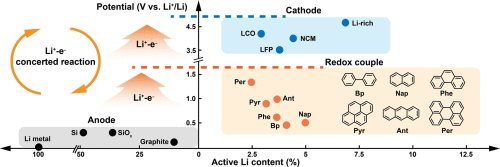Energy & Critical Metals
Researchers develop efficient and mild lithium extracting strategy based on potential controllable redox couples
Recycling lithium-ion batteries is difficult. The recovery of lithium of a quality high enough to be used again is complicated and expensive. Most recycling…

Recycling lithium-ion batteries is difficult. The recovery of lithium of a quality high enough to be used again is complicated and expensive. Most recycling processes are targeted at extracting the lithium from cathodes (where most of the lithium in discharged batteries is located). However, it then precipitates out together with other metals contained in the cathode and must be painstakingly separated.
Extraction from the anodes, which consist primarily of graphite, is significantly more efficient and can be carried out without discharging the battery beforehand. Because of their high reactivity, however, the risk of fires and explosions is high if the anodes are leached out with aqueous solutions, as is usual. These reactions release large amounts of energy and may produce hydrogen.
Now, a team led by Yu-Guo Guo and Qinghai Meng at the Institute of Chemistry of the Chinese Academy of Sciences (ICCAS) and the University of Chinese Academy of Sciences (UCAS) has developed an alternative method that avoids these problems. Instead of water, they use aprotic organic solutions to recover lithium from anodes. Aprotic substances cannot release any hydrogen ions, so no hydrogen gas can form.
A paper on the work is published in the journal Angewandte Chemie.
The solutions consist of a polycyclic aromatic hydrocarbon (PAH) and an ether as the solvent. Certain PAHs can take up a positively charged lithium ion from the graphite anode together with one electron. Under mild conditions, this redox reaction is controlled and very efficient.
Chang et al.
With the PAH pyrene in tetraethylene glycol dimethyl ether, it was possible to dissolve the active lithium from the anodes almost completely.
An additional advantage is that the resulting lithium-PAH solutions can be used directly as reagents, for example, in adding lithium to new anodes in preprocessing or in regenerating spent cathodes. The PAH/solvent system can be varied to optimize it for the material being treated.
This recovery process is efficient and inexpensive, reduces safety risks, avoids waste, and opens new prospects for the sustainable recycling of lithium-ion batteries.
Resources
-
Chang, X., Fan, M., Yuan, B., Gu, C.-F., He, W.-H., Li, C., Feng, X.-X., Xin, S., Meng, Q., Wan, L.-J., Guo, Y.-G. (2023) “Potential Controllable Redox Couple for Mild and Efficient Lithium Recovery from Spent Batteries” Angew. Chem. Int. Ed. doi: 10.1002/anie.202310435

Uranium Exploration Company Announces Additional Staking in the Athabasca Basin
Source: Streetwise Reports 12/22/2023
Skyharbour Resources Ltd. announced an update from its Canada-based Falcon Project along with additional…
Tesla Launches New Mega Factory Project In Shanghai, Designed To Manufacture 10,000 Megapacks Per Year
Tesla Launches New Mega Factory Project In Shanghai, Designed To Manufacture 10,000 Megapacks Per Year
Tesla has launched a new mega factory…
Giving thanks and taking stock after “a remarkable year”
An end-of-year thank you to our readers, industry colleagues and advertisers before Electric Autonomy breaks from publishing until Jan. 2
The post Giving…











